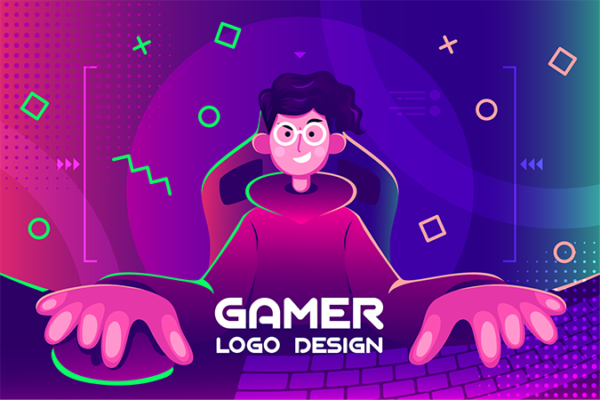
Once you’ve set up your ideas, designed your website, and are ready to launch your brand, it’s time to create a logo that defines you.
Whether you’re a small business or part of a big corporation, a website needs a brand. It’s as simple as that. Your blog logo not only enhances your website but also allows you to spread your brand across multiple platforms.
Table of Contents
Reasons you need a logo for your blog
When starting a blog, one thing to remember is that there are many people with the same idea. No matter what you want to write about, someone wrote about it already. This situation doesn’t mean, however, that you shouldn’t write at all. On the contrary! Perhaps people look for our outlook specifically.
There are more than 20 million blog post views on WordPress, and about 77% of people on the internet use websites to gain more knowledge.
When people find your website for the first time and visit it, you want them to remember you. A logo is a perfect way to help you with this, as it gives your readers something to remember you.
Aside from having more visibility, a blog logo design will also help you to:
- Have an excellent first impression. A well-designed image will inspire your readers to continue reading and piques the interest of newcomers and encourage them to visit your blog.
- Show professionalism. A good trademark symbol shows others that your blog is professional. It also shows that you know what you’re talking about when you write.
- Create an identity. Your logo tells things about you or your business, so it is the face of your brand. It creates a bond with your customers and helps to establish trust between you and your readers.
- Be recognized. A logo that stands out is a brand that people will remember. Having a well-designed trademark creates recognition and makes it easier for people to find you.
What kind of blog logo designs are there?
There are about nine types of trademarks that you can separate into three categories: icons, text, and combined logos (meaning they use both words and images).
Many websites use a word-based logo. The trademark bases itself upon the title of the blog. Either as a full name, a monogram, or an abbreviation. Nothing more and nothing less. The typeface you use is telling for this type of logo.
Of course, you can also combine a fitting symbol with the name of your online journal to create a combination trademark. It represents your site and the content you post.
When creating a trademark for your website, we discourage using a solo image. This image on its own may be hard for people to distinguish since it doesn’t have any name added to it. Your trademark needs to build your brand, not destroy it. You want to be recognized, so if you own a blog, it’s wise to either use letters or a combination of letters and imagery.
Now that we’ve discussed this, it’s time to move on to the designing. We have collected five simple steps for you to help you create the perfect logo for your blog.
Five steps to help you design your trademark
- Who is your audience?
Deciding on your audience may be the most crucial part of the designing process. It influences all the future decisions you will make as well. It doesn’t matter if you own travel, food, or business websites; they need to connect to the audience you want to reach. Start by thinking of the subjects you want to discuss. Who would be the ideal readers for this topic, and what do you want to achieve with this? Write down identifying details about your potential audience and make connections to their supposed hobbies and demographics. What makes their hobbies relevant, you ask? Look at it from this perspective: if you write about anxiety and depression, would a brightly-colored theme help make a connection to your readers? It wouldn’t. The same goes for a fitness blog with a design black/white layout.
Before checking the next step from your list, try to make sure your blog is suitable for the audience of your choosing. - What colors will you be using?
The colors of your trademark symbol shouldn’t vary too much from the color scheme of your website. If you don’t have a website yet, you’re in luck! You can decide whether you want to choose colors complimentary to your website or the other way around.
However, most bloggers already have a website (or template, if they use WordPress) as soon as they start designing their logo. What you need to pay close attention to is that the colors you pick will invoke certain emotions in your viewers. Every single color has different effects associated with it and influences your audience. While red promotes passion and energy, blue will convey a feeling of trust and power. Before picking a color, make sure that you know the effects it has. Aside from loose colors, you can also choose color palettes that work well together. With the right combination, your website colors complement the style you use, both in looks and in underlying meaning. Be sure not to pick more than three colors as it may get too crowded or confusing for your readers. Too many colors also make your website look cluttered, rather than organized.
While most of your marketing and displaying will be online, you need to make sure that your logo looks good in print too. This confirmation will help you when you decide on printing business cards or flyers. - Choose a suiting font
Especially when you’ve chosen a word-based logo, this step is crucial for the future of your blog. A font is what your audience focuses on when visiting your blog. Therefore, it’s essential to pick a font that suits your style and personality. When you use a combination logo, don’t skip this step, as it’s vital for you as well! Trademarks often use one of four types of fonts available. However, for a blog, brands tend to be unique and use custom fonts to stand out from the crowd.
Keep in mind that typefaces use the same qualifications as colors: they need to connect to your blog and your audience. The type of blog should reflect your intentions. You wouldn’t use comic sans for a blog about taxes, just like you wouldn’t use a formal font for a children’s creative blog. One last thing to check before moving forward is the readability. Some fonts, especially typefaces used for creating blogs, are hard to read. If this is the case, it defeats the whole purpose of your trademark in the first place. Always think of your customer or visitor type when creating a logo. If they have no issues identifying your brand, you have done an excellent job. In any other case, you may need to edit your imagery or font types. - Make multiple versions
When you’ve reached step four, you have probably already decided on the elements you want to incorporate in your trademark. Before you launch it, make sure to create a few different versions to see which one suits you best.
Try playing around with different colors, shades, or typefaces. Look at each separate element and decide whether they create a beautiful, fitting result. Also, make sure to change the position of each component. What makes your trademark work best? Text in the center, or above an image? What about your image placement?
Create about four to five different versions and look at them from different perspectives. If it helps, you could ask some friends or family to give feedback; they have different views than you do.
Lastly, the size of your logo varies per theme you use. With some websites, your logo may look very large, while on others, it’s minimal and almost invisible. Make sure your logo is easy to read, with proper dimensions and perfect resolution. - What’s your design method?
Once you’ve tried out different variations of your logo, it’s time to create it for real!
How can you get a professional logo for your website
Of course, you can create your logo by using photoshop or similar programs. However, you can also make use of one of the online logo-makers or professional design platforms.
Whichever you choose is up to you. To help you get started, we put down some of our favorite options for you to pick:
Eztuto Studio. There is a reason you’re reading this article on our website. We will design your logo with the information and preferences you give us. This option allows you to receive a logo without the added stress of creating one yourself.
Adobe Photoshop. Who doesn’t know photoshop? This program is suitable for the creation of professional trademarks and much more. However, you do need to pay for this software if you want to use it to its full capacity. If you do not have much design experience, it may also be hard to get started. Try out a free trial first before committing to the full program.
PicMonkey. This tool is free to use and even has an online logo maker. While it does not have all the options Photoshop offers, you can still make a great logo with it.
Canva. Canva focuses mainly on designs for social media, but it’s also perfectly suitable to create a brand for your blog. This platform offers many templates, including a logo maker.



